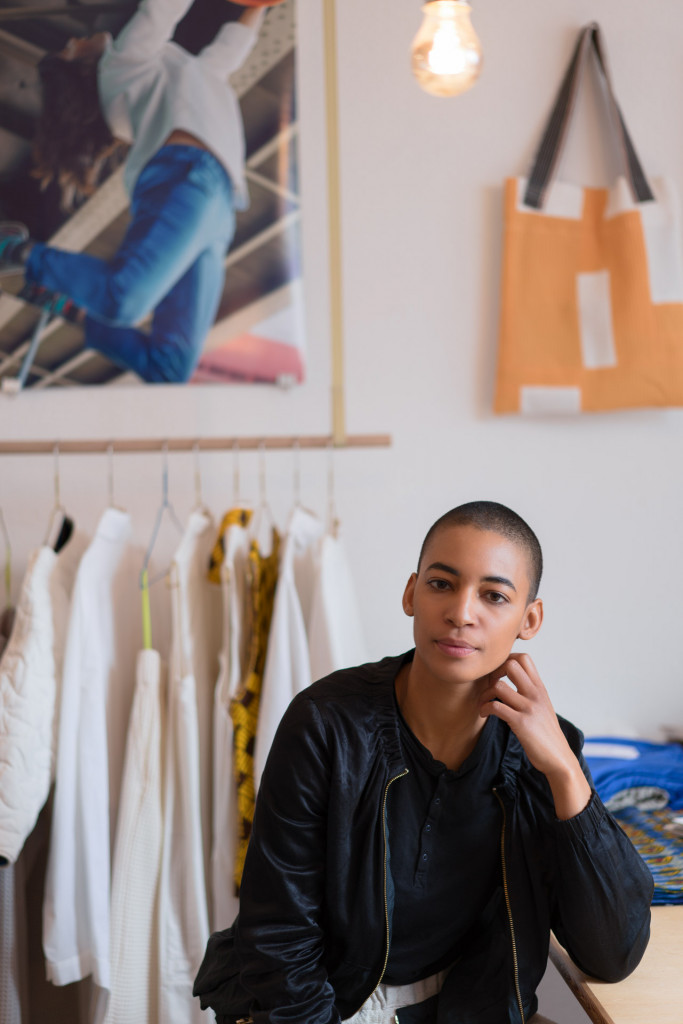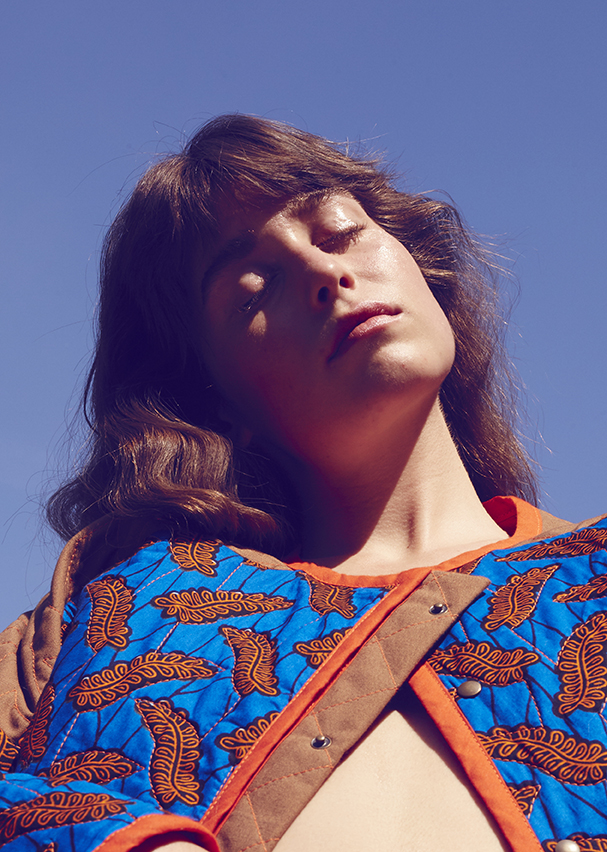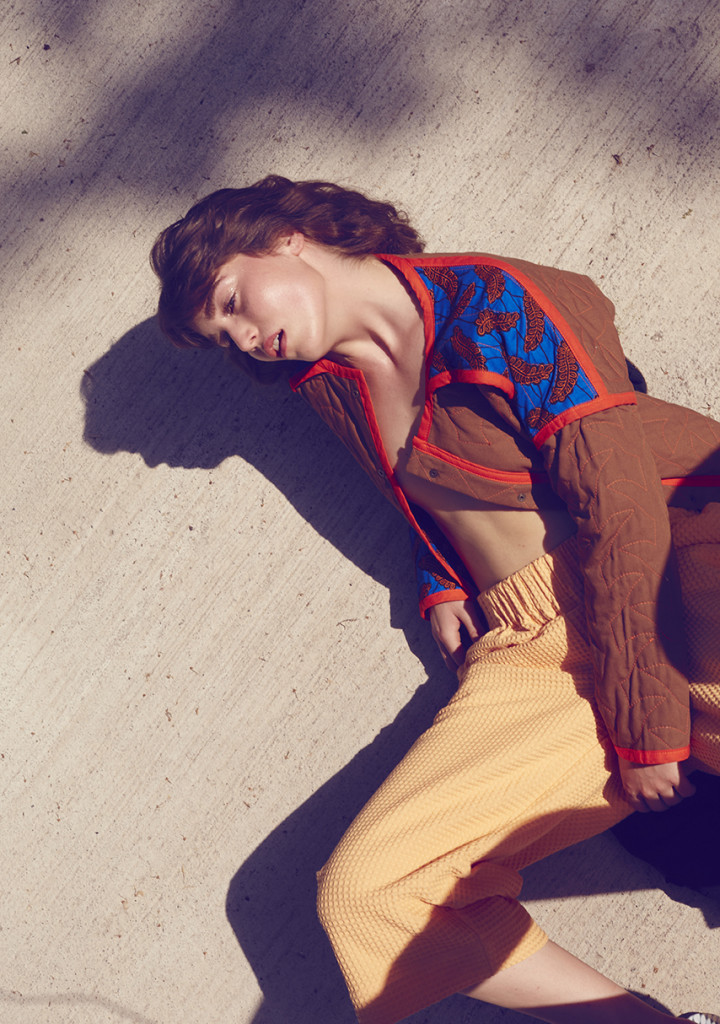I met Buki when she was showing her eponymous line Buki Akomolafe at Neonyt, a biannual international fair for sustainable fashion held in Berlin back in January of this year. Her clothing line jumped to the foreground with its bold but minimal silhouettes and striking use of color, pattern, and textures, especially with the quilted reversible pieces that feature African wax print fabrics. And every piece is handmade in Berlin! This spring, I visited Buki in her atelier in the Kreuzberg area of Berlin to speak further, surrounded by the bright, confident colors and shapes of her clothing which cut through the grey mood of the overcast spring day.
The reversibility of Buki’s signature quilted pieces speaks to the duality that informs and influences Buki’s work, as she draws from both her Nigerian and German cultures. A duality can also be seen in her fashion training. She first studied fashion in Stuttgart, where she learned how to sew and make patterns. After completing a fashion internship in Berlin, she decided to continue her studies at HTW Berlin, the University of Applied Sciences. In Berlin, Buki found “it was more about the creative part; we had a lot of time to be creative. We did one outfit in six months and in Stuttgart we had to sketch a collection every two weeks; it was more like when you work in a company. The school here was freer—you could express yourself. It was the perfect match to do both schools.

I can see your clothing is very technical in some ways.
Yes, some pieces are very technical and some are more emotional and free. I try to mix it and make a fusion out of it.
Within my collections, I have a basic range with a lot of shirts. The shirts are tailored with sharp shapes and the patterns are very technical. Then I add the quilt pieces that are technical in a way as well because of the quilting technique I use. But the way I do the quilting is more free and emotional, so I choose different kinds of patterns and a lot of colors. I look at the patterns (for the clothing) and prints and do a lot of experiments with the quilting to see which quilting design is going to be best. Because you can wear the quilted pieces on both sides, they need to look good on both sides; therefore, it takes a lot of time to define the stitches.
Do you do the quilting freehand on the machine? Yes. Wow, that’s really impressive. It’s a lot of work.
I’m also impressed by how the quilting creates organic shapes but they are quite precise. There’s a regularity and pattern to them.
Yes, so what I do starts with choosing the fabric and the print. When I chose the prints I always think about how I can do the stitches/quilting because I actually follow the lines of the print. Not all of the lines—I go through a process to see which lines I’m going to follow—but the print designs the quilting in the end. That’s why each print is quilted differently.
You add another dimension to the print because it becomes sculptural that way. Exactly. How do you choose and source your prints?
It first starts with the colors I want to use and then [I choose] the prints. The way I want to have the quilting at the end, I can’t use every pattern. Maybe I can, but I don’t want to.
Right now I source from Vlisco in the Netherlands because actually it’s the main producer of these African wax prints. At first I wanted to source them in Nigeria where I grew up or in Western Africa but there is almost no fabric production so you can’t really find fabrics made there. Then I realized that most of the fabrics are made in the Netherlands so I decided to buy them directly here. It’s not ethical to fly to Africa to buy fabrics that come from the Netherlands.
You mentioned that your work also addresses your identity in a way. Did you partially grow up in Nigeria?
I was born in Germany. When I was almost a year old, my parents and I moved to Nigeria because my father started an NGO project in Ondo State, three to four hours from Lagos in the southwest. My parents built the project together from scratch. My father does mainly permaculture stuff—agricultural projects with topics like women’s empowerment.
I lived there for 6 years and went to school. I already started to be in contact with fabrics and sewing there because my father’s project had a women’s workshop where they dyed fabrics and sewed their own clothing. So that was something I already experienced when I was young.
We moved back to Germany because my mom wanted my siblings and me to get our education here. I’ve lived in Germany since then.
That must have been quite a transition. Were you able to continue this relationship with clothing when you moved back to Germany?
With fabrics and sewing? I didn’t really do it in Germany but my mom knits and does those kinds of things. When I was young I always wanted to design my own clothing. I would sketch it and then my mom had to sew it. One day she said, ‘Okay. I’m going to show you how to sew.’
And here we are. So you source the print fabrics in Netherlands, what about the cottons and other plain fabrics?
I have one main supplier in southwest Germany that focuses on organic and certified fabrics, so the cottons and other plain fabrics are all organic cotton and certified. I source the other fabrics through a textile agency in Berlin that is mainly focused on certified fabrics. That took a long time in the beginning; I did one year of research into how to source fabric. I wanted to focus on working with organic fabrics and when I started, there already was this movement of working with sustainable fabrics but not a big pool of fabrics. Now it’s easier to source nice fabrics. In the beginning you could only get plain white, not this big range of colors and textures.

Was it always your plan to have your own line when you were in school?
Not really…maybe in a way but I didn’t know it yet. I always loved doing fashion and loved creating things but I never loved the system and the way it’s going or where we are right now. When I was in Berlin for my studies, I realized that it’s really nice to do your own thing. I wanted to work in fashion but not in the classical fashion field. For me, the only option was to do my own thing because I wanted to stay in Berlin. You have some brands here but all brands are struggling in a way so I thought it was good to do my own thing. Especially with my background and identity—I wanted to use both influences in my work and I could only do that with my own label. I launched it in 2016, and before that I did a lot of research.
Can you share how your identity informs your creativity and design work?
For me, that’s my main topic. I am always between the two cultures, I really feel. I realized that in my work, I have both. What we have in West Africa is more that you follow your feeling. You work differently than in Germany because in Germany you have rules. If you do a pattern, it has to be like this. There [in West Africa] it’s more like: it doesn’t have to be like this; you can just do it the way you feel.
I always start with perfect measurements and [plans] but then I end up working in an organic way, so I really mix it. It’s the same with the colors. I love basic and simple things, but at the same time I love to go wild with color and sort of crazy shapes. So yes, I just mix everything.
It’s these two different approaches coming together.
Exactly. And with the fabrics: for me, it was important to use the African wax prints but I wanted to use them in a different way. If I explain to people what I do, I tell them that I use African fabrics for example and [then] they have one specific picture in mind. I want to change that [preconception] with what I do with the quilting and the wax prints.
How did you come to work with quilting?
It’s funny—in the beginning I didn’t like quilting at all. I really hated it. When I did my final collection at school, my inspiration was Senegal. I went to Senegal six times during my studies because my boyfriend and some friends started a social project with handicapped people. We travel to Senegal every year to work on the project. I fell in love with the country, the people, the culture—everything. There’s a specific group called the Baye Fall; it’s a religious Sufi group but they live the Sufi style in a different way—they dress and look like Rastafarians. They have a totally interesting way of clothing themselves because they don’t buy anything; they just create their clothing from old fabric scraps so they have a lot of patchwork styles and layers. I was impressed by their style so I wrote my thesis about them and Senegal.
I just knew that I wanted to work with African fabrics. I started to do research and patchwork but I didn’t want to do classical patchwork. At the beginning I did a lot of experiments with patch–working and African wax prints. I came to quilting because you mostly find patchwork quilted blankets and I discovered a lot of nice quilting techniques. I started to do the quilting stitches with the fabrics and following the lines of the prints. I ended up liking it and working with it.
Your work is truly this mix of two cultures—also geographically. The seed came from there, you brought it back with you and went through the whole process here. In a way, you used the more European or German process to arrive.
That’s true. There are also the shapes. It’s funny—all my patterns and shapes are made for a woman but they’re male patterns because what I loved in Senegal is the clothing of the man, not the clothing of the woman. All the shapes are inspired by the men’s clothing there.
Is the clothing you make geared to women or do you find your customers are of both (or all) genders?
I would say it’s both genders. Some pieces are made more for women. But a lot of men are interested in the pieces and I have done photo shoots with men and women. I think most of the pieces fit both.
How do you schedule your collections?
I just do one collection a year. With the techniques it takes quite a bit of time. I think 90 percent of the collection is quite contemporary so even some pieces I made in 2016 are still ‘in fashion’—if you’re going to use the term ‘in fashion.’ That’s why I don’t want to produce too many pieces. For me it’s really important how you buy clothing and how you use it, and not to buy so many things and too often. That’s why I want to slow down and do one collection a year. And I have the basic range for several years and sometimes I just change the colors.
Would you like to produce or design your own prints in the future?
I would really love to do that some day. Sometimes when I research prints, I like the colors but I would [prefer] a different shape.
I studied textile design as well, and I was surprised to learn that what we think of as really good African wax print is actually made in the Netherlands.
Actually the African wax print is not the traditional fabric you find in West Africa or all over Africa because they used to have woven fabric, and especially in West Africa, the small strips. So that is something unique to the area. African wax prints were brought to Africa through the Dutch people in the 1800s from Indonesia. It’s actually an Indonesian (batik) technique that was transformed. Of course it has changed over the years so now you could say it’s the African one, but it’s not the traditional fabric you find there.
Do you plan to work with more of the traditional fabrics?
I already do; I do bags out of fabric leftover from cutting and the straps are the traditional woven fabric from West Africa. I also started to experiment with the fabrics. I definitely want to use the traditional fabrics more and source them directly to support the artisans.

Was this your first time showing at Neonyt? Yes. How was that experience for you?
It was really good to be in this platform because I didn’t participate at all in Berlin Fashion Week before. I just had a small private showroom at Paris Fashion Week. It was really good to show the collection to the Berlin fashion scene and to be amongst other designers who have a sustainable approach. It was a great experience. At other fashion weeks you don’t have this specific ethical fashion scene, or you have the scene but you don’t have the platform.
Because I only do one collection a year, I have to find a way and a system to show my work. I believe that the whole system will change—it has to change with the seasons because we’re already seeing that less people attend the trade fairs. We have to find other solutions and ways to show our garments to the people or buyers. I think it will change and the way of representing is going to be different in the future.
Also, your clothing can take someone through the year because you have all these layering pieces. You’re right; the buyers have to think about things differently and not be so rigid in terms of seasons, spring/summer…
Yes, because even the weather is changing. We don’t really have seasons. Of course we still have seasons but they’re not as specific as they have been some years ago. It’s really changing and we have to adapt to the changes—or create new options, new platforms, and everything.
It seems with your personal history you couldn’t do anything other than make fashion in a sustainable way, with your conscious choices about sourcing and the rest.
Yes, while I was studying it was the one thing that I always had in mind and always tried to work on. We started to work with sustainable fabrics during my studies, but at the time it was difficult to find them.
With my family and my father’s project, everything is sustainable and conscious—more in the agricultural way, not so much with clothing. But that was something that I grew up with and it’s important for me.
It’s a personal value. Yes. I suppose with modern life and living in a big city, people can be really cut off from what happens during the production of the food we’re eating or the clothing that we’re wearing.
Yes. I realize that it’s becoming more and more important to be transparent because a lot of people don’t know what happens in between (in production) and they don’t know the cost of each step. It’s important to talk about it and share our knowledge. I didn’t know a lot of the things happening in fashion before—I learned through my internships and studies. So I think it’s really important to inform people because people are really lazy today. We are overwhelmed with a lot of information. If we don’t get the information directly, we just ignore it so it’s important to share what we know.
Buki Akomolafe
studio + showroom
Heimstrasse 17
10965 Berlin
@bukiakomolafe







0 thoughts on “Buki Akomolafe: bridging the cultures of two continents with thoughtful fashion”